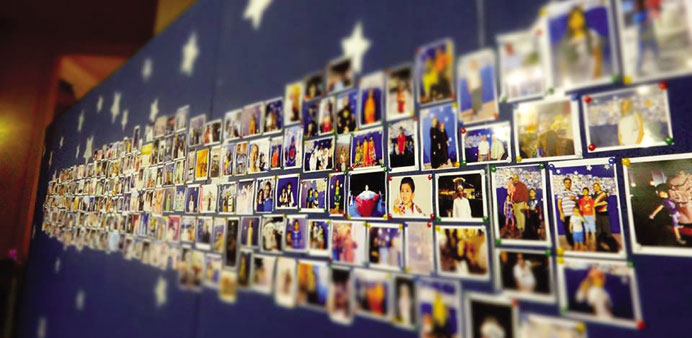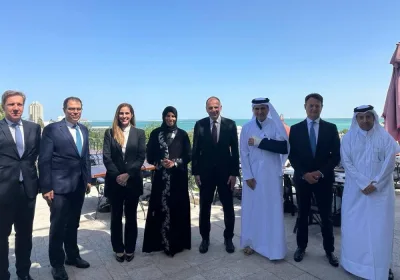MAGNIFICENT MURAL: The wall has more than 400 photographs. The Katara Stars ends tomorrow and all the contributed photographs will be stored in Katara’s archives.
For almost a month, Katara Stars posted selfies taken by locals, residents and visitors of Qatar. Now, this astounding piece of street art has become a testament to the country’s unity in diversity. By Anand Holla
At Katara, a big blue wall with a few white stars scattered about, has been a vibrant testament to the idea of all are one and one is all. Throughout this Ramadan, Katara Stars – which is a giant mural made of selfies taken by people of Qatar – has thrived on diversity to piece together what appears to be a fairly complex, contemporary portrait of the country.
As Katara Stars comes to a close tomorrow, the spectacular collage on the “Ramadan wall” that captures the various hues of Qatar and turns common folk into stars compels us to see the beauty in unity of multiplicity.
What started on July 3 as a call to visitors of Katara to contribute to an outdoor photography gallery has snowballed into an all-encompassing, crowd-sourced mural that neatly blends a sense of community and society with street art. Underlining the spirit of Ramadan, visitors were asked to take selfies or photos with their family and friends anywhere at Katara, which was bustling with the choicest of Ramadan-related events.
To make it on the wall installed between Building 16 and 18 in Katara, visitors could either post it on Instagram by using the hashtag #katarastars or mail it to [email protected]. The more dedicated sorts were welcome to even submit their printed 10cm by 15cm photos at the venue.
The centre of the six-panel wall started off with a handful of pictures stuck on it and two weeks later, the width of the wall was covered with a mosaic of beaming faces. The continuing overwhelming response has seen the wall art expand and it now showcases more than 400 photographs. Once Katara Stars ends tomorrow, all the contributed photographs will be stored in Katara’s archives.
While a good number of the selfies on display have been taken at the wall site, there are many that are creatively shot all over Katara; from the beach front to the bylanes inside the cultural village. Kids hugging each other, couples smiling, men dressed in traditional Arab attire; the result of the project is a feeling of encapsulating Qatar as a family, while infusing colour into this year’s Ramadan.
One of the organising officials present at the site, who wished to be unnamed, said, “An interesting observation to be made is that you can see photos of people from all nationalities, social and economic backgrounds. So this is a place where everyone meets – from the cleaner to the Sheikh, from a famous singer to a security guard. They are all here on the wall, smiling. Everyone is connected through art, and here, it doesn’t matter where you are from. The final mural is like a big patchwork to which everyone has added. It’s like a mirror of what this country is.”
What also marks the uniqueness of this wall is that it puts out something like a real-life Instagram that can be enjoyed outdoors. Katara Stars refer to this idea of having physical photographs before our eyes as getting back “analog feelings in this digital world.”
The official said, “The use of social networks is so big nowadays that we share all our pictures virtually. So much so that to share them physically feels strange. So the idea is also to get people to think about it. In the end, Katara Stars is a street art event. It’s about taking art from the gallery and bringing it to the street in a participatory way.”
The concept of pooling in people’s creativity and identity to form a unique piece of work is courtesy Wallpeople. A collaborative art project that was founded in Barcelona in 2009 invites people to create and be part of a unique moment in a specific urban space. The initiative tries to promote the creativity of people and reclaim public space as a way of expression and citizen interaction. In the last edition, more than 11,000 people from 47 cities around the globe, such as New York, Rio de Janeiro, Mexico DF, Sydney, and Berlin, participated in the event. Each edition has a different subject and last year’s was music.
Participants were asked to either reinterpret a song in an artistic format of their choice, such as illustration, photography, text, painting, collage, or canvas, or create any work related to music in a general way, like say a tribute to an artist, or a favourite genre of music.
Doha is the first city in the Gulf to join the bandwagon of this fascinating concept and Katara Stars has decidedly focused on Ramadan as its driving force, since the festival is a period of both reflection and celebration.
The philosophy of Wallpeople believes in free creativity and uses Internet and its digital tools to offer their experiences in real life, and somehow raise a reflection on how we create and communicate today. Being a collective experiment, Wallpeople has always been open to making inroads into new countries.
Wallpeople started in Barcelona because its founders, advertising creatives Pablo Quijano and David Marcos, felt the need to give life to urban art as they saw the streets losing such interesting form of expression and interaction with people.
BELOW:
A look at the Wallpeople project-1.



